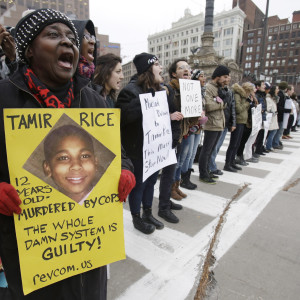I met Tamir Rice in Baghdad. Not Tamir himself, of course, but a boy very much like him. My situation, however, played out a little differently than Tamir’s.
It was early evening, about 5:00 PM or so, in March of 2004. My civil affairs team and some of my soldiers had just left the Tisa Nissan District Council Hall in route for Camp War Eagle. About five minutes into the ride, our fiberglass, doorless Humvees rolled into a small market area that, because of the time of day, was a little busy with pedestrian traffic. The route was routine, so I didn’t pay much attention to the bustle. To us, it was a regular day.
Disrupting the relative peace of a routine drive, one of my soldiers shouted that he spotted a kid off to our right on the sidewalk with an AK-47. Without hesitation, the civil affairs team leader brought our vehicles to a halt and led us on foot to the area in question. He was standing amongst a small group of older men who all were drinking tea around a small table.
Our sudden presence startled the relaxing group. We immediately lowered our weapons, which quickly put them all at ease. As our soldiers passively stood guard, the civil affairs team leader and I inspected the kid’s AK and instantly realized that it was a toy. There clearly was no threat. We were, of course, relieved.
With the assistance of our interpreter and using positive body language and hand gestures, we told the kid–and the adults present–that though the AK was only a toy, he should be more careful in case soldiers who were not familiar with the neighborhood and its people happened to drive through. After all, they might not be as cautious as we were. The civil affairs team leader and I lightened the mood by explaining to the kid that we too had played with toy guns when we were kids, just like every American boy. We patted him on the head and gave him a fist bump, shook the adults’ hands, and rolled out without any incident to report.
Avoiding unnecessary violence on that street was no accident; in fact, it was part of the ‘rules of engagement’ for how the U.S. military, in this case the soldiers of 1st Squadron, 2nd Armored Cavalry Regiment, operates every day. We are trained to deescalate potentially dangerous situations by making ourselves visible and approachable and communicating first (either verbally, or through use of signals). Only as a last resort do we aim our weapons at anyone, for doing so means that we are preparing to pull the trigger. Through the leadership of our squadron commander, it was important that we were an integral part of the community; that we were not just seen as soldiers, but as people who genuinely cared for the welfare of those in the district.
It is sad that I, an officer in the U.S. Army operating in a combat zone, was able to consistently show on an everyday basis more constraint and compassion than police officers. I love kids, and I can’t imagine what my life would be like if I or any of my soldiers would have killed that boy in a hasty rush to judgement. If we soldiers can slow down and use our training to diffuse the tensest and most dangerous of situations and make the right call, it’s time for police officers across the United States to do the same.

